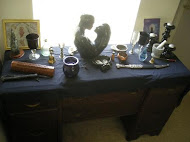
The origin of the word Turquoise is French and comes from Venetian Traders, who bought it from the great bazaars in Turkey. In antiquity, Pliny had named it callais, Greek kalos lithos for "beautiful stone." The color of turquoise ranges from sky blue through various shades of green to greenish and yellowish gray. Turquoise is opaque except in the thinnest splinters, and has a feeble, faintly waxy luster. The most valuable specimens of turquoise are a robin’s egg blue or deep-blue azure. North American specimens contain impurities that form matrix streaks within the stones. The veins are inclusions from nearby rock fragments or oxides and form during the creation of Turquoise. The veins in some stones interlock in patterns to form "spider-web" turquoise. Turquoise is a controversial stone because most of the stones sold have received so many treatments that the final product is completely different from its original form. Enhancements can include, plastic, wax and oils that change color, durability and polish.
Most Turquoise deposits are in arid to semi-arid regions in igneous rock formations that contain high copper concentrations. Deposits of Turquoise can be found in Afghanistan, Africa, Armenia, Australia, Brazil, Chile, China, Egypt, Europe, Iran, Israel, Kazakhstan, Mexico, Russia, Siberia, Tanzania, Turkey, and the United States. The finest of the world’s Turquoise specimens come from the deposits in Northeastern Iran. The stones from here have the much sought after Robin’s Egg Blue with few or no streaks and are among the most valuable opaque gemstones, while less precious stones come from North America and are greener (from iron) than the Persian stones. There are Turquoise deposits in New Mexico, Nevada, Arizona, Virginia, California and Colorado.
Turquoise with its blue hue, is among the oldest known gemstones. Turquoise was obtained from the Sinai Peninsula before the 4th millennium BC in one of the world's first important hard-rock mining operations. These revered stones, so important to the Persian culture, were called Ferozah, which meant victorious. It was an important ornamental mineral for use in jewelry and other object by the ancient Egyptians. It graced the necks of Egyptian Pharaohs and adorned the ceremonial dress of early native Americans. In 1900, archaeologists who excavated the tomb of the Egyptian Queen Zer (5500 BC) found a Turquoise and gold bracelet on her wrist. These are the world’s oldest known examples of surviving jewelry. The Breastplate of the Hebrew High Priest Aaron contained twelve stones set in four rows. Turquoise was the first stone on the second row. In the 16th century, the cultures of the American Southwest used Turquoise as currency. It was also often found on the facades of Indian homes. By the middle of the first millennium, AD, China had begun using Turquoise, and Japan’s use of Turquoise began in the 18th Century AD. Around 500 BC, inhabitants in Siberia had begun using the stone, but it did not gain favor with Western European fashion until the late middle ages.
As a healing stone, Turquoise is among the crystal healing master stones. According to followers of the New Age, its powers can benefit the whole body, with special strengths in healing ailments of the immune, respiratory, waste and skeletal systems. Crystal healers recommend it for detoxification of alcohol, poison, pollution or radiation in the body, treatment of high blood pressure, asthma, infections, TMJ and dental problems. Modern Spiritualists consider Turquoise to be a stone of spiritual attunement, cleansing, protection and prosperity and a symbol of the Earth and sky, good fortune and success. In the world of crystal healing, Turquoise is supposed to be a stone of communication. New Age healers recommend it for people who have a fear of public speaking. They believe it has the ability to make a speaker more eloquent, loving, creative and honest. But it is also improves the mental state overall by increasing all of the following positive mental characteristics: serenity, creativity, empathy, positive thinking, sensitivity, intuition, happiness and wisdom - all of which result in a calmer state that leads to greater self-realization. It is also considered a stone of friendship. As a communication stone, the New Age believers say that it opens up the connections between friends and allowing love to flow in those communications, which strengthens the friendship bond. Further, they believe it has the power to strengthen convictions, courage and personal power. It radiates calming and protective vibrations, and restores healthy mental attitude. Turquoise is androgynous with a good balance of yin and yang.
Turquoise has been attributed with healing powers as well as promoting the wearer's status and wealth. A very special stone indeed, Turquoise is a sacred stone to many American Indian tribes and has been used in various jewelry items. The Navajo culture of New Mexico and Arizona utilized Turquoise in their rain ceremonies - they believe that a piece of Turquoise is actually a piece of the sky that has fallen to Earth - which required the tossing of the stone into a river. Some cultures said it was important in ensuring the fortunes of warriors, hunters, and all tribal members. The Apache felt that Turquoise combined the powers of the sky and the sea to help hunters and warriors aim accurately. The superstitions of the Zuni said that Turquoise could protect them from demons.
Many ancient cultures held beliefs about turquoise. In Greece, Turkey, Egypt, and Tibet Turquoise represents purity. Because of its color, it is an ancient symbol of the sky. Some cultures consider it a bridge between heaven and Earth. It was said that dipping Turquoise in water gave the water the ability to cure bladder ailments. It could heal the eye simply by looking at it. Having seen the reflection of the new moon in a stone of Turquoise, a person was believed to encounter good luck soon, according to Persian lore. Arabian superstition said it was a lucky stone and that it had good powers of benevolence. They also attributed the accumulation of wealth and prosperity to the stone. The religion of the Hindus said that it could accumulate wealth and Tibetans believe that while turquoise can ensure good fortune, it can also guard one’s health, and protect against the evil eye. The people of Afghanistan, Persia, India, and Arabia thought that a Turquoise stone that changed color was an omen of illnesses or death. Muslim beliefs say that a change in Turquoise’s color meant that a woman had been unfaithful. Arab writings from the 12th century warned that a pale stone meant polluted air or a change in the weather. Europeans of the middle ages said that Turquoise would lose its color when the wearer contracted an illness and was a gauge of the general health of a person.
With all the legend and myth surrounding turquoise, it has come to symbolize many things in modern life. Spiritualists say it changes color from dark to light - it has been thought to warn the wearer of danger or illness by changing color. This myth has survived to modern times. It is an excellent token of protection for physical and astral travel and vision quests, during which it acts as a grounding force, strengthening the user against fear of the unknown by enhancing one’s feelings of trust, kindness, wisdom and understanding. It can ward off strong negativity and protect from the evil eye, reptile bites and diseases of the eye. Further, Shamans extend its protective powers to one’s property. Worn for courage, an amulet for travelers, or amulet for horses and their riders - in the 13th century, turquoise was thought to protect the wearer from falling, especially from horses. It should be worn during, and used in money attracting spells. It is good for self realization, understanding, communication, the elevation of goals, relaxation, calming emotions and easing stress. Turquoise promotes luck and healing, provides protection and balancing, and increases courage, money, love, and friends. It is the primary holy stone of Native Americans. Turquoise is said to take on characteristics of the wearer, and one belief is that it is unwise to wear a turquoise formerly worn by one who has died. Excellent for both spiritual attunement and healing of the energy centers and the physical body, purifies all levels of being and is capable of handling strong negativity.
Overall, Turquoise is said to open all chakras, allowing the stone’s powers of love and communication to flow through the entire being. However, healers associate it primarily with the Throat or 5th chakra. This Chakra is the center of communication, creativity, serenity and spiritual bonding. Turquoise can also benefit the operation of the Heart Chakra by opening it up for giving and receiving love. On the brow Chakra, it strengthens the connection to great spirit. The blue color has come to symbolizes the spirit or sky source for spiritualists.
Sources:















No comments:
Post a Comment